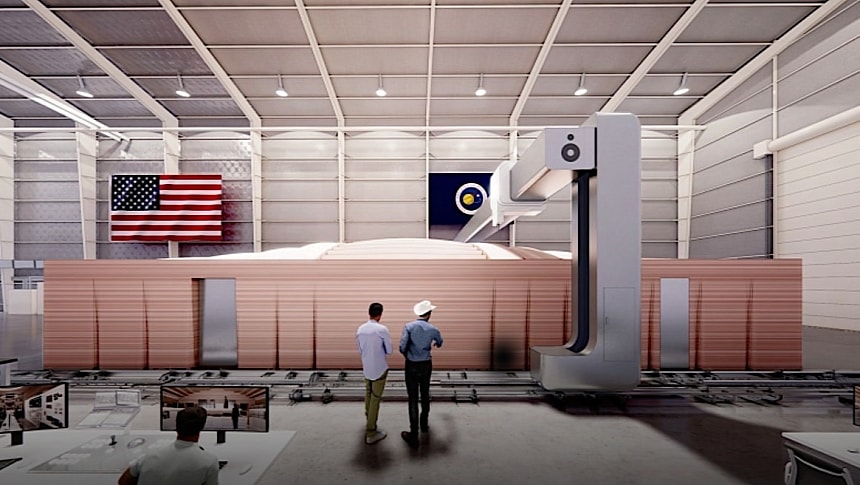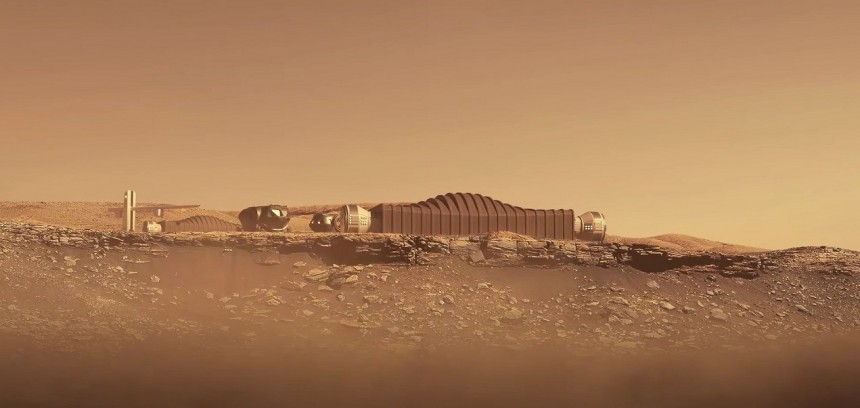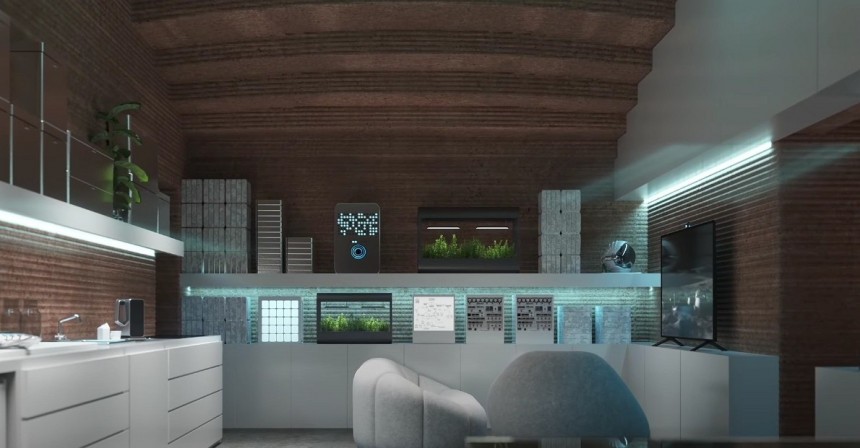You've probably heard about people locking themselves up in isolated habitats before. They tend to do this in a bid to determine what it would take to survive the harsh conditions of another world in our solar system. But whereas most of these exercises don't really lead to any actual mission, NASA's CHAPEA just might.
CHAPEA is an acronym for Crew Health and Performance Exploration Analog. As partially explained by the extended name, it is a project meant to simulate living on Mars with the goal of learning more about how human health and performance are affected by lengthy isolation and scarcity of resources.
The project is centered around a 1,700-square-foot habitat constructed at the Johnson Space Center in Houston, Texas. OK, maybe not constructed, but rather 3D printed by a company that made a name for itself in erecting buildings this way: ICON.
The facility is called Mars Dune Alpha and was described at the time when it was announced as "the highest-fidelity simulated habitat ever constructed by humans." It was segmented in four private crew quarters at on one end, dedicated workstations, medical and food-growing stations at the other one, and living spaces in between.
The habitat was imagined with varying ceiling heights, segmented by an arching shell structure, in a bid to make life easier on the occupants by providing a sort of diversity in the limited landscape at the crew's disposal.
The place was equipped with both fixed and movable furniture as to allow the crew to configure the space to suit their needs. Ways to customize the lighting, temperature, and sound control were also included in the build.
We first got wind of CHAPEA back in 2021, when the American space agency also announced the requirements for the people who wished to pretend to live on Mars for more than a year: U.S. citizens or permanent residents, healthy, non-smoking, and aged between 30 and 55 years old.
A master's degree from an accredited institution in a STEM field (meaning engineering, biological science, physical science, computer science or mathematics) was also a must. And to top it all off, the pretend journey to Mars was to be reserved for people with two or more years of professional experience in a STEM field, or at least 1,000 hours as pilot-in-command on jet aircraft.
It's not public knowledge how many people who meet those criteria applied to be part of the CHAPEA Mission 1 crew, but we know the names of the four who made it through the selection process: Kelly Haston (commander), Ross Brockwell (flight engineer), Nathan Jones (medical officer), and Anca Selariu (science officer).
These people entered the habitat on June 25, 2023, and they set to work simulating life in an isolated environment on Mars. For more than a year, they performed a series of missions, including robotic operations, habitat maintenance, exercise, and crop growth. The cherry on the cake were the simulated marswalks.
If you think the four had it easy, think again. Some of the missions mentioned above, but also everyday living, had to take place in challenging circumstances, with each member being subjected to intentional environmental stressors like resource limitation, isolation, and confinement.
The mock communication with Earth was performed with a life-like delay of up to 44 minutes roundtrip, something that probably had quite an effect on the crew.
On July 6, 2024, 378 days after they had entered the CHAPEA habitat, the four people stepped back into the real world, and you can see how that went in the video attached below.
The four were to spend the next two weeks after their exit going through a series of data-collection activities, in a bid to give the space agency a better understanding of what happened inside the habitat.
The mission that just ended is the first in a series of three NASA has planned for the immediate future. CHAPEA Mission 2 is scheduled to "depart” in 2025, followed by the third one at an undisclosed date.
Both remaining crews will have to spend a year inside, and they will be subjected to the exact conditions and requirements as the current crew. Such an approach is needed, says NASA, because it's the only way to "collect data from more participants to expand the dataset and provide a broader perspective on the impacts of Mars-realistic resource limitations, isolation and confinement on human health and performance."
I said at the beginning of this piece that this project may very well inform a mission to Mars, and that's because NASA is actively pursuing a crewed mission to the neighboring planet. The task at hand is gargantuan, so CHAPEA is not the only simulation being conducted.
NASA is working in parallel on something called the Human Exploration Research Analog (HERA), it too located at the Johnson Space Center. This habitat is 650 square feet (60 square meters) and can house crews for about 45 days at a time.
Research conducted in Antarctica, but also missions to the International Space Station (ISS) as used as well to gather data for a potential trip to the Red Planet.
Unlike all the others, though, CHAPEA offers more on-point insight, thanks to the comms delay and a more limited food system.
The project is centered around a 1,700-square-foot habitat constructed at the Johnson Space Center in Houston, Texas. OK, maybe not constructed, but rather 3D printed by a company that made a name for itself in erecting buildings this way: ICON.
The facility is called Mars Dune Alpha and was described at the time when it was announced as "the highest-fidelity simulated habitat ever constructed by humans." It was segmented in four private crew quarters at on one end, dedicated workstations, medical and food-growing stations at the other one, and living spaces in between.
The habitat was imagined with varying ceiling heights, segmented by an arching shell structure, in a bid to make life easier on the occupants by providing a sort of diversity in the limited landscape at the crew's disposal.
The place was equipped with both fixed and movable furniture as to allow the crew to configure the space to suit their needs. Ways to customize the lighting, temperature, and sound control were also included in the build.
A master's degree from an accredited institution in a STEM field (meaning engineering, biological science, physical science, computer science or mathematics) was also a must. And to top it all off, the pretend journey to Mars was to be reserved for people with two or more years of professional experience in a STEM field, or at least 1,000 hours as pilot-in-command on jet aircraft.
It's not public knowledge how many people who meet those criteria applied to be part of the CHAPEA Mission 1 crew, but we know the names of the four who made it through the selection process: Kelly Haston (commander), Ross Brockwell (flight engineer), Nathan Jones (medical officer), and Anca Selariu (science officer).
These people entered the habitat on June 25, 2023, and they set to work simulating life in an isolated environment on Mars. For more than a year, they performed a series of missions, including robotic operations, habitat maintenance, exercise, and crop growth. The cherry on the cake were the simulated marswalks.
If you think the four had it easy, think again. Some of the missions mentioned above, but also everyday living, had to take place in challenging circumstances, with each member being subjected to intentional environmental stressors like resource limitation, isolation, and confinement.
On July 6, 2024, 378 days after they had entered the CHAPEA habitat, the four people stepped back into the real world, and you can see how that went in the video attached below.
The four were to spend the next two weeks after their exit going through a series of data-collection activities, in a bid to give the space agency a better understanding of what happened inside the habitat.
The mission that just ended is the first in a series of three NASA has planned for the immediate future. CHAPEA Mission 2 is scheduled to "depart” in 2025, followed by the third one at an undisclosed date.
Both remaining crews will have to spend a year inside, and they will be subjected to the exact conditions and requirements as the current crew. Such an approach is needed, says NASA, because it's the only way to "collect data from more participants to expand the dataset and provide a broader perspective on the impacts of Mars-realistic resource limitations, isolation and confinement on human health and performance."
I said at the beginning of this piece that this project may very well inform a mission to Mars, and that's because NASA is actively pursuing a crewed mission to the neighboring planet. The task at hand is gargantuan, so CHAPEA is not the only simulation being conducted.
NASA is working in parallel on something called the Human Exploration Research Analog (HERA), it too located at the Johnson Space Center. This habitat is 650 square feet (60 square meters) and can house crews for about 45 days at a time.
Research conducted in Antarctica, but also missions to the International Space Station (ISS) as used as well to gather data for a potential trip to the Red Planet.
Unlike all the others, though, CHAPEA offers more on-point insight, thanks to the comms delay and a more limited food system.










